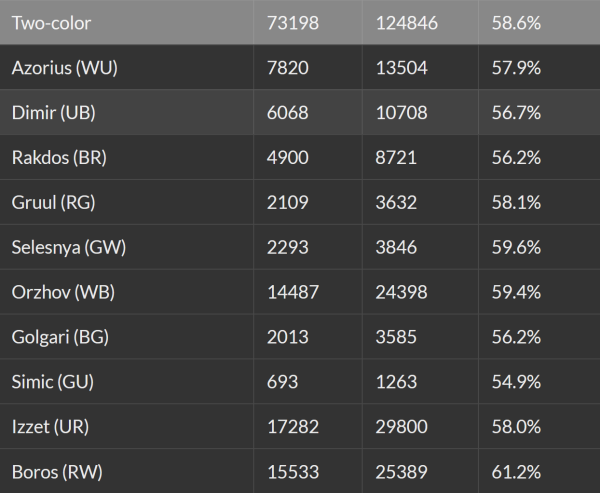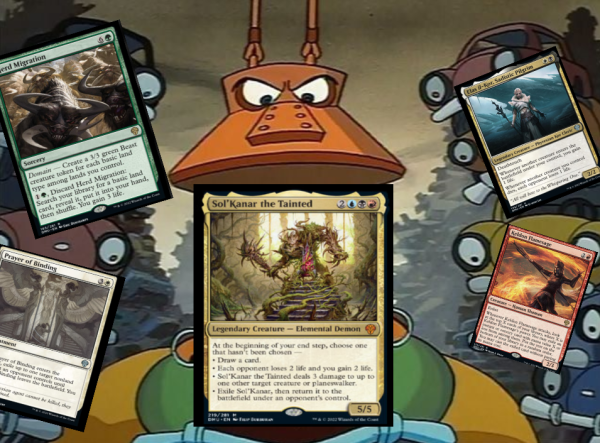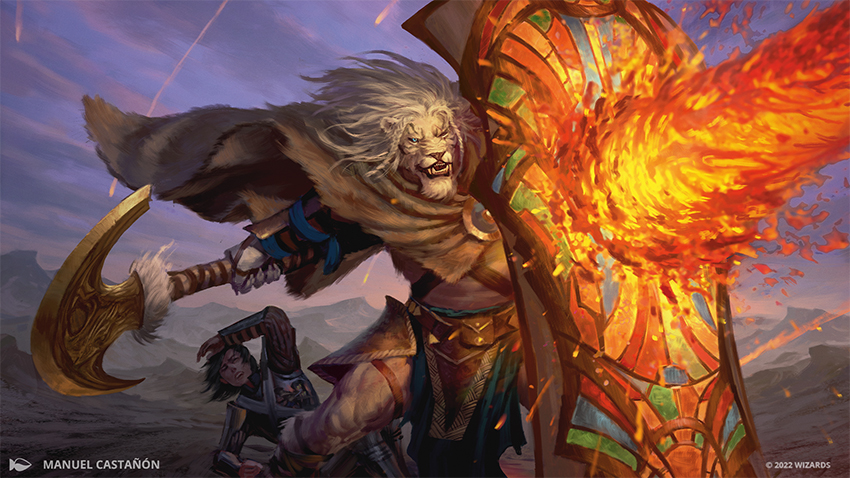Are you a Quiet Speculation member?
If not, now is a perfect time to join up! Our powerful tools, breaking-news analysis, and exclusive Discord channel will make sure you stay up to date and ahead of the curve.
Pillars are decks that define the structure of a Limited format. They establish rules of engagement for the rest of the metagame. Each pillar has a clear and hearty game plan rooted in its commons. We should expect to see versions of these decks in every draft. Cards and colors outside these pillars are relegated to support roles. We can think of these as the crossbeams. They are tools that can strengthen multiple decks, and create variations on the pillars. Understanding both the pillars and the crossbeams and how they fit together is important for deck construction in any format.
Understanding Format Pillars in Dominaria United
We should consider these pillars as we're drafting and building our decks. Because of their power level, they make for the best and most reliable archetypes. Dominaria United (DMU) is defined by three pillars: Spell-based Blue decks, Domain, and creature-based White decks.
Spell-Based Blue
Typically UR or UB, these decks cast a high volume of cheap spells and find payoffs in Tolarian Terror, Tribute to Urborg, Balmor, Battlemage Captain, and Haunting Figment. This is probably the strongest archetype and the easiest to assemble at common.
Domain
In the first stages of the format, the Domain decks relied on an overwhelming endgame, with all sorts of kicker spells, uncommons, and rares to overpower opponents. Sunbathing Rootwalla has overtaken the Floriferous Vinewall as the two-drop of choice in all but the most controlling Domain decks and has opened up a more assertive approach to the strategy.
Creature-Based White Decks
These decks look to apply early pressure, win timely combat with Take Up the Shield, and deploy Argivian Phalanx well before its casting cost indicates. This assertive strategy can win with a rush of damage or win by accruing value on the board.
What About Wingmantle Chaplain?
The Defender deck is often referred to as the scourge of the format. However, I would argue that the defender package is most commonly found in one of these archetypes. Usually, it's in an Esper Spells deck or a Domain deck with lots of recursion. While it often feels like its own archetype, it's usually just a sub-archetype of one of the pillars.
What About Red and Black?
Red and black are the crossbeams of DMU, acting as supporting colors in the format. They lack premium synergies that we want to build toward but accentuate the gameplay of each pillar. They narrow the focus of the pillars above. In short, red looks to accelerate gameplay, while black looks to slow it down.
Consider the Spells archetype. The UB version is a control deck, upgrading Tribute to Urborg into hard removal. Ghitu Amplifier and red's burn spells accelerate the clock and push us towards a more assertive tempo deck. Similarly, the Go-Wide White decks gain access to Keldon Strike Team and the kicker on Heroic Charge, or get Gibbering Barricade and Bone Splinters to generate value.
The difference between Domain Stompy and Domain Control is the difference between kicking Colossal Growth versus kicking Urborg Repossession. One goes fast, and the other looks to go slow.
It's also why the RB decks perform the worst compared to the others. The color combination offers strong cards, but they don't coalesce into well-supported and consistent synergies.

A note on the data: While GU and GB have comparably low ratings, this represents a misuse of the color's identity. Slower Green decks should include splash cards and additional colors to win in the late game. GR and GW benefit from being more assertive and sacrificing less in a two-color deck. In general, we should try and avoid RB as a deck. It can potentially win, but it needs very high card quality to do so consistently.

Synergies at Common
The most commonly exchanged currency in Limited formats is creatures. Almost all decks rely on them. Being rewarded for playing creatures is like finding out there's a buy one get one sale on something you already wanted.
The spells in this format are efficient and we have time to cast them. This is not an aggressive format, so we're incentivized to play cards like Impulse and Timely Interference, which in turn makes cards like Essence Scatter much better. The spell-based decks incentivize us to do something that already works.
Similarly, the fixing in this format is plentiful with the dual lands. We already want to be splashing the powerful kickers, and the ten uncommon legends, so getting extra incentive makes this a strong strategy.
Red and Black are crossbeams, because while they have an identity, they lack an effective strategy at common. Black wants creatures in the graveyard to help rush out Withering Necromass. However, the only common that helps us do that is Eerie Soultender. Our cards will eventually trade off, but it's hard to accelerate that process profitably. Red has a lot of good cards as well, but its best commons are cheap interaction and a Domain payoff in Meria's Outrider.
When Pillars Crumble Into Piles
As we navigate each draft, we want to find a home in one of the pillars. Sometimes though, those pillars crumble. Sometimes we straddle between strategies, chasing high-power cards. Sometimes some overlapping synergies cause us to lose focus. Often, this leaves us with a deck lacking a clear identity, or a clear game plan. These decks are lovingly referred to as "piles".

Whether it be greed, experimentation, or just not seeing enough fixing to take these piles to a specific deck type, we still want to optimize our chances of winning.
The Mortar Holding the Pile Together
"Piles" often contain a number of high-power cards, but lack the cohesion of the pillars. To build a winning deck might require some extra mortar to hold them together. I want to highlight some key cards that helped me salvage some piles.
Salvaged Manaworker
Typically these "pile" decks have mana issues. Salvatore is a nice way to help out the mana as well as provide a cheap body. We discussed this little construct last week, but this list would be incomplete without his inclusion.
Sheoldred's Restoration
I find many of my "piles" end up being control decks gone wrong. As a result, I often need some life and have a Writhing Necromass or Tolarian Terror in my graveyard. Gaining seven life and getting a 5/5 via Sheoldred's Restoration is a powerful play and stunts aggression effectively. You're probably in a bad spot though if you can't kick it.
Artillery Blast
These decks are rarely going to be aggressive and Artillery Blast can still kill stuff.
Battle-Rage Blessing
The poor man's Take Up the Shield, Battle-Rage Blessing works nicely with the many menace creatures in the format.
Aggressive Sabotage
A bad two for one is still a two for one.
Automatic Librarian
Automatic Librarian provides colorless card selection without a loss of tempo. It can help us find the pieces we need.
Goblin Picker and Thrill of Possibility
These both allow us to trade our trash for treasure. When our deck is built from mismatched parts, tossing away one piece in search of another can be a winning strategy.
Draft Chaff
Navigating between pillars and power is what makes each draft a unique experience. At the heart of all this discussion is the central theme of all Magic advice: Always have a plan. All formats have pillars, and knowing them is a huge advantage.
The three pillars of the format represent the most common and easiest to assemble plans. Most of our decks should use those strategies. We read the table as best we can, and try to find the open lane. However, uncertainty and temptation can cause chaos. The pillars are important, but it's also necessary to know how to operate in the space between them. Each pillar has many versions. Learning the ins and outs of each, as well as the nuances and variations they offer will serve us well.





